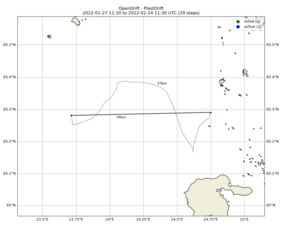Four weeks ago in our Plastics in the sea campaign we headed to the northernmost part of the Baltic Sea, to the Bay of Bothnia, and started to follow the journey of a plastic wrapper, that fell into the sea close to city of Oulu. The sea was already frozen in end of December, when our virtual plastic wrapper fell to sea from a ferry that connects the Island of Hailuoto to the mainland. The wrapper slipped under the fast ice and the currents transported it slowly under the ice, especially, if compared to the speed of the plastic items in our other incidents. In those first 4 weeks, the wrapper drifted in total about 80 km, zigzagging on its way, and ended about 40 km north-west of the starting location, north of Hailuoto.
During the second four-week period, the drifting pace of the wrapper has remained about the same as on the first period. The road has not been straight on this period either, bu the item is now about 50 km away from where it was four weeks ago. It is south of the Haparanda Archipelago National park and seems to be heading west towards the Swedish coast and the Luleå Archipelago. Distance to the last mentioned one is about 50 km, so should the item stay on this course and move at the same pace, it might reach there by the end of March.
But the ice conditions and their impact on the drifting patterns make this an interesting case. The whole of Gulf of Bothnia, of bay of Bothnia is the northernmost part, is covered by ice, as can be seen from the Finnish Meteorological Institutes' current ice chart. On the coast there is fast ice in most places, which stretches out to the sea, but there is also a lot of consolidated ice and very close or compact ice. When there is strong winds, these can push ice together into ridged or hummocked ice, or rafted ice. The thickness of the ice varies a lot, from 10 cm to up to 70 cm. Simulating the journey of a plastic item in this kind of sea, which is mostly covered by ice, but where there are smaller cracks and bigger, channels that have been opened by ice breakers, is more difficult than in open sea. And the currents work differently under the sea, they are not as strong as in open sea. But the wrapper is moving. And from its current position it would still have to travel about 130 nautical miles or 240 km to the south beyond Kvarken (between cities of Umeå in Sweden and Vaasa in Finland) to reach open, ice water sea. That is roughly the distance that the ships heading to and from the ports at the bottom of the Bay of Bothnia have to travel through ice to make it to open, ice free sea. That would not be possible without the assistance of the ice breakers, which keep the shipping lanes open and make year around shipping from the region possible.
On next Friday we return back to the Norwegian coast to find out where is our virtual bottle. Is it still trapped in a narrow fjord, or has it escaped back out to the Norwegian Sea?

